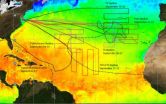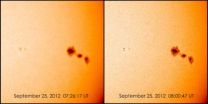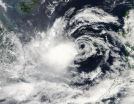(Press-News.org) NASA's Hurricane and Severe Storm Sentinel or HS3 scientists had a fascinating tropical cyclone to study in long-lived Hurricane Nadine. NASA's Global Hawk aircraft has investigated Nadine five times during the storm's lifetime.
NASA's Global Hawk also circled around the eastern side of Hurricane Leslie when it initially flew from NASA's Dryden Research Flight Center, Edwards Air Force Base, Calif. to the HS3 base at NASA's Wallops Flight Facility, Wallops Island, Va. on Sept. 6-7, 2012.
Nadine has been a great tropical cyclone to study because it has lived so long and has strengthened to hurricane status a couple of times, and then weakened back into a tropical storm. Hurricane Nadine is an anomaly because it has been tracking through the North Atlantic since Sept. 11, when it developed as the fourteenth tropical system of the hurricane season.
Longest-lived Tropical Cyclones
As of Oct. 2, Nadine has been alive in the north Atlantic for 21 days. According to NOAA, in the Atlantic Ocean, Hurricane Ginger lasted 28 days in 1971. The Pacific Ocean holds the record, though as Hurricane/Typhoon John lasted 31 days. John was "born" in the Eastern North Pacific, crossed the International Dateline and moved through the Western North Pacific over 31 days during August and September 1994. Nadine, however, is in the top 50 longest-lasting tropical cyclones in either ocean basin.
First Flight into Nadine
On Sept. 11, as part of NASA's HS3 mission, the Global Hawk aircraft took off from NASA Wallops at 7:06 a.m. EDT and headed for Tropical Depression 14, which at the time of take-off, was still a developing low pressure area called System 91L.
At 11 a.m. EDT that day, Tropical Depression 14 was located near 16.3 North latitude and 43.1 West longitude, about 1,210 miles (1,950 km) east of the Lesser Antilles. The depression had maximum sustained winds near 35 mph. It was moving to the west near 10 mph (17 kmh) and had a minimum central pressure of 1006 millibars.
NASA's Global Hawk landed back at Wallops Flight Facility, Wallops Island, Va., on Sept. 12 after spending 11 hours gathering data in the storm, which had strengthened into Tropical Storm Nadine during the early morning hours of Sept. 12.
The Global Hawk, one of two associated with the HS3 mission, sought to determine whether hot, dry and dusty air associated with the Saharan air layer was being ingested into the storm. This Saharan air typically crosses westward over the Atlantic Ocean and potentially affects tropical cyclone formation and intensification. During its 26-hour flight around Nadine, the Global Hawk covered more than one million square kilometers (386,100 square miles) going back and forth over the storm in what's called a "lawnmower pattern." The Global Hawk captured data using instruments aboard the aircraft and also dropped sensors called sondes into the storm. These sondes are small sensors tied to parachutes that drift down through the storm measuring winds, temperature and humidity.
Second Flight into Tropical Storm Nadine
The Global Hawk investigated Tropical Storm Nadine again on Sept. 14 and 15. During its 22.5 hour flight around Nadine, the Global Hawk covered more than one million square kilometers (386,100 square miles) going again went back and forth over the storm in another lawnmower pattern.
"During the flight, Nadine strengthened from a tropical storm to a hurricane despite being hit by very strong westerly winds at upper levels and very dry air on its periphery," said Scott Braun, HS3 Mission principal investigator from NASA's Goddard Space Flight Center, Greenbelt, Md. Data from this flight will help scientists determine how a storm like Nadine can intensify even in the presence of seemingly adverse conditions.
Third Flight into Tropical Storm Nadine
NASA's Global Hawk unmanned aircraft departed from NASA Wallops at 2:42 p.m. EDT on Wednesday, Sept. 19 and crossed the Atlantic to take additional measurements in Tropical Storm Nadine. Both the Global Hawk and NASA's TRMM satellite noticed that Nadine had continued to display tropical characteristics, indicating that it had not transitioned to an extra-tropical storm. An extra-tropical storm is one that loses its tropical characteristics, such as when the core of the storm changes from a warm core to a cold core, like a typical mid-latitude low pressure system that is associated with fronts. At that time, Nadine was located in the Atlantic a few hundred miles southwest of the Azores Island.
The science portion of the third flight was completed on Sept. 20. Scientists reported that they obtained excellent data from the dropsonde system, which showed some winds on the western side of the storm still reaching 60 knots (69 mph/111 kmh) at middle levels and possibly one measurement of near 60 knots (69 mph/111 kmh) near the surface. The data suggested that Nadine was still a tropical system rather than an extra-tropical system.
The three science instruments aboard the Global Hawk performed extremely well, transmitting data back to NASA Wallops for the scientists to analyze and discuss. The plane observed Nadine for more than 12 hours. Forecasters at the National Hurricane Center were using the data supplied by NASA's Global Hawk and noted in the discussion of Nadine at 11 a.m. EDT on Sept. 20, "The current intensity is kept at 45 knots (51.7 mph/83.3 kmh)…is in good agreement with dropsonde data from the NASA Global Hawk aircraft and AMSU [instrument] estimates."
Fourth Flight Over Nadine
The fourth science flight of NASA's Global Hawk over Nadine concluded when the aircraft landed at NASA Wallops on Sunday, Sept. 23. The HS3 mission scientists changed the flight path during the Global Hawk flight to be able to overfly Nadine's center that day.
"Measurements from dropsondes found wind speeds greater than 60 knots (69 mph/111 kph) at lower levels above the surface during that adjusted flight leg," said Scott Braun. "Despite the large distance of Nadine from the U. S. East Coast, the Global Hawk was able to spend about 11 hours over the storm."
Fifth Flight Over Nadine
The Global Hawk aircraft's fifth investigation of Nadine occurred on Sept. 26 with the aircraft returning to NASA Wallops the next day. While over Tropical Storm Nadine, the storm had maximum sustained winds near 60 mph (95 kmh). Despite adverse conditions, the storm re-intensified to a hurricane the next day, so the HS3 data captured the precursor conditions for intensification.
The NASA HS3 Mission Goals
The HS3 mission targets the processes that underlie hurricane formation and intensity change. The data collected will help scientists decipher the relative roles of the large-scale environment and internal storm processes that shape these systems.
HS3 is supported by several NASA centers including Wallops; Goddard; Dryden; Ames Research Center, Moffett Field, Calif.; Marshall Space Flight Center, Huntsville, Ala.; and the Jet Propulsion Laboratory, Pasadena, Calif. HS3 also has collaborations with partners from government agencies and academia.
HS3 is an Earth Venture mission funded by NASA's Science Mission Directorate in Washington. Earth Venture missions are managed by NASA's Earth System Science Pathfinder Program at the agency's Langley Research Center in Hampton, Va. The HS3 mission is managed by the Earth Science Project Office at NASA Ames.
INFORMATION:
NASA's HS3 mission thoroughly investigates long-lived Hurricane Nadine
2012-10-06
ELSE PRESS RELEASES FROM THIS DATE:
Getting NASA's SDO into focus
2012-10-06
From Sept. 6 to Sept. 29, 2012, NASA's Solar Dynamic Observatory (SDO) moved into its semi-annual eclipse season, a time when Earth blocks the telescope's view of the sun for a period of time each day. Scientists choose orbits for solar telescopes to minimize eclipses as much as possible, but they are a fact of life -– one that comes with a period of fuzzy imagery directly after the eclipse.
The Helioseismic and Magnetic Imager (HMI) on SDO observes the sun through a glass window. The window can change shape in response to temperature changes, and does so dramatically ...
NASA sees very strong wind shear battering Tropical Storm Gaemi
2012-10-06
It is easy to see the effect of the strong northeasterly wind shear battering Tropical Storm Gaemi in satellite imagery from NASA. Visible imagery on Oct. 5 shows a large oval-shaped area of showers and thunderstorms associated with the storm, southwest of the exposed center of circulation.
NASA's Aqua satellite passed over Tropical Storm Gaemi as it was approaching Vietnam on Oct. 5, 2012 at 0550 UTC (1:50 a.m. EDT). A true-color image of the storm was captured by the Moderate Resolution Imaging Spectroradiometer (MODIS) instrument and shows bulk of showers and thunderstorms ...
BUSM study investigates genetic variants' role in increasing Parkinson's disease risk
2012-10-06
(Boston) – Boston University School of Medicine (BUSM) investigators have led the first genome-wide evaluation of genetic variants associated with Parkinson's disease (PD). The study, which is published online in PLOS ONE, points to the involvement of specific genes and alterations in their expression as influencing the risk for developing PD.
Jeanne Latourelle, DSc, assistant professor of neurology at BUSM, served as the study's lead author and Richard H. Myers, PhD, professor of neurology at BUSM, served as the study's principal investigator and senior author.
A ...
The Largest Electric Power Expo of China Unveils in Beijing Smart Grid Technology in the Spotlight
2012-10-06
With the rapid development of industrialization and urbanization in China, the demand for electricity continues to grow, according to a report by State Grid Corporation of China. Exploring and utilizing renewable energy, enhancing energy efficiency are significant to the energy supply, energy structure adjustment and energy-saving in China. Being the No. 1 Electric Power Expo in China, The 14th International Exhibition on Electric Power Equipment and Technology, The 7th International Exhibition on Electrical Equipment and 2012 International Exhibition on Electric Power ...
Puja Sapra, Director, Oncology Research Unit at Pfizer Will Give a Featured Presentation at the 5th ImmunoTherapeutics & ImmunoMonitoring Conference (Jan 31 - Feb 1, 2013 in San Diego)
2012-10-06
Puja Sapra, Director, Oncology Research Unit at Pfizer Will Give a Featured Presentation on "Design Considerations For Development of an Optimal Antibody-Drug Conjugate" at the 5th ImmunoTherapeutics & ImmunoMonitoring Conference (Jan 31 - Feb 1, 2013 in San Diego)
Antibody-drug conjugates (ADCs) represent a promising therapeutic modality for the clinical management of cancer. Dr. Puja Sapra will use case studies to elaborate on the multifaceted optimization required to yield a viable clinical candidate ADC. ADCs employing different mechanism of action ...
New Start-Up bMighty2 Helps Small Businesses Spread Their Message Via the Internet
2012-10-06
Powered by a team with years of experience in marketing, technology, and design, bMighty2 is a new digital marketing agency that promises to help small businesses find success online.
The start-up will help small businesses leverage the Internet and Web 2.0 for their marketing needs using a multi-channel approach. Services to be offered by bMighty2 include website development, local search engine optimization, email marketing, social media marketing, and directory link building.
"bMighty2 was built from the ground up to help small businesses understand and ...
Local Non-Profit Announces FUBU Co-Founder as National Spokesperson.
2012-10-06
We are pleased to announce One Community, One Voice, One Vision National Spokesperson, Mr. Keith Perrin, Jr. The vision of OCOVOV aligns perfectly with his passion to give back and support our communities. Mr. Perrin is an accomplished, well known entrepreneur who successfully introduced FUBU clothing apparel brand to the world with his three business partners. He says, "Sometimes all it takes is
ONE opportunity to make a difference. Giving back to others is the main focus of One Community One Voice One Vision and that is why I am honored to be the national spokesperson ...
E1/Ethernet Tester with Advanced Heat Radiation System
2012-10-06
Toronto, Canada - GAO Comm (www.GAOComm.com) has announced the release of its E1/Ethernet tester which conducts 50b/s to 2048 b/s error testing and tests over multiple V ports. This tester is a comprehensive test tool for E1, V port, Gigabit Ethernet link maintenance and failure diagnosis.
This small and convenient E1/Ethernet tester, model A0050004, features easy operation, a rugged dustproof design and advanced heat radiation system. It has PPPoE, FTP download, terminal emulation and Web browsing functions. It also provides a large number of Ethernet diagnostic tools ...
Tapping into Your Innermost Feelings with Joe Vitale's Healing Song
2012-10-06
10-5-2012 (JoeDolanPR): "The Healing Song" is the 4th CD in a series of health inspiring music from self-help singer-songwriter and star in the hit film "The Secret", Dr. Joe Vitale. Offering 11 songs to stimulate the senses, relax the mind and offer the benefit of better health through the power of music, "The Healing Song" captures the ability to reach inside one's deepest concerns and help create a solution to issues that cause stress and body pain.
"Think about some of the movies you've seen. Jaws wouldn't be the same without its ...
Simon Joseph LLC Has Partnered with iWebContent
2012-10-06
Simon Joseph LLC is pleased to announce they have created a partnership with iWebContent to improve their rankings with the search engines and find better ways to reach out to their target audience. Simon Joseph is a general contracting company that provides a long list of services to both businesses and homeowners. Their goal is to work with iWebContent to spread the word about their business and bring in more customers.
Simon Joseph works with companies and homeowners to determine exactly what type of work they need on their building or homes. Their contractors will ...


